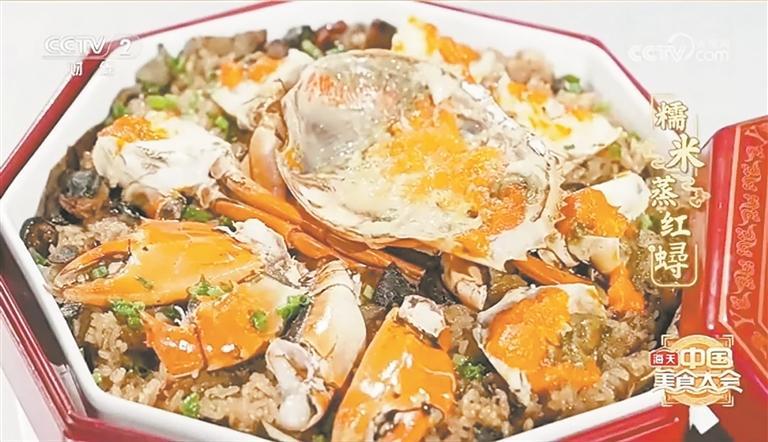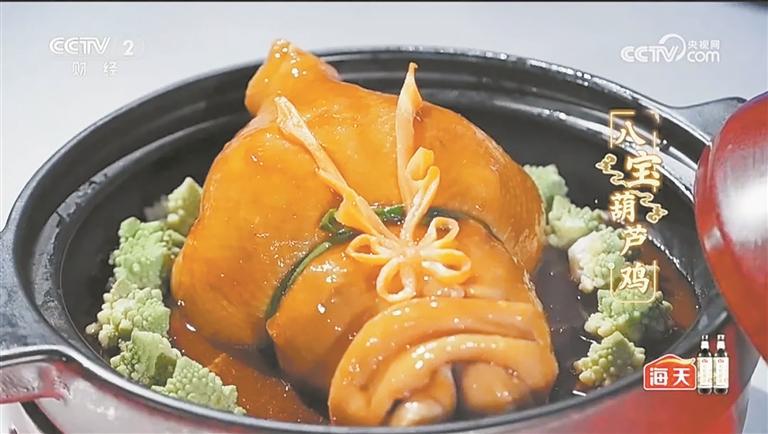- Guide
- Flavors

Culinary Preparation Scene

Pomegranate Taro Paste

Glutinous Rice Steamed Red Crab

Eight-Treasure Gourd Chicken
Authentic Flavors Reflect Everyday Life
On March 15 at 6:00 PM, the eighth episode of Chinese Food Conference aired simultaneously on CCTV-2 (China Central Television's Finance Channel), Yangshipin, and CCTV.com. This episode featured distinguished culinary experts from Quanzhou, who showcased an array of local delicacies.
Renowned chef Xie Jiali from Shishi introduced Pomegranate Taro Paste, a handcrafted dish made from locally grown betel taro. The dish comprises stir-fried taro paste encasing an eight-treasure filling of mushrooms, dried shrimp, water chestnuts, smoked bamboo shoots, and pork, deep-fried to golden perfection. Its crispy exterior, smooth taro paste, and flavorful core captivated host Gao Bo and gourmet judge Wang Bingbing, offering a new perspective on taro-based cuisine.
Chef Wang Chunnong presented Old Duck and Sea Eel Casserole, a classic home-style dish that combines freshly caught sea eel and free-range duck. The careful selection of ingredients results in a rich, golden broth infused with deep, authentic flavors.
Highlighting the influence of Southeast Asian culinary traditions, Du Wuhan introduced Satay Beef Crystal Tube, a dish reflecting the flavors brought to Fujian by overseas Chinese. This fusion creation pairs tender beef with a uniquely adapted satay sauce, blending its slightly sweet and nutty notes with translucent rice tubes, evoking nostalgic memories of Hokkien emigrants' culinary heritage.
From Shishi, Chen Zhiyong showcased Eight-Treasure Gourd Chicken, a Fujian specialty where a deboned whole chicken is filled with an eight-ingredient stuffing and shaped into a gourd—an auspicious symbol in Chinese culture. This dish embodies both rich flavors and a heartfelt wish for prosperity and good fortune.
Signature Dishes Captivate Viewers
On March 8 at 6:00 PM, the seventh episode of Chinese Food Conference celebrated culinary mastery, emphasizing techniques that elevate the natural essence of ingredients.
Veteran chef Cai Shuwan, with 40 years of experience, presented her signature Beef Soup. Carefully selected beef is cut into strips, marinated, and meticulously hand-mixed with sweet potato starch for 40 minutes. These precise yet straightforward steps result in a silky, flavorful dish that epitomizes the essence of regional cuisine.
Jinjiang's Ye Canhui introduced Ginger Duck, a celebrated Quanzhou specialty. Fresh Muscovy duck is slow-cooked with fiery Yongchun ginger, with no additional water used. This labor-intensive slow-frying process enhances the duck's natural richness, creating an aromatic and deeply flavorful dish.
From Shishi, chef Xu Zipeng prepared Braised Pig Trotters, a staple at Hokkien banquets. This dish is slow-simmered for two hours with mushrooms, dried squid, star anise, and other spices, producing succulent, richly flavored meat that is indulgent yet balanced.
Wu Shaoquan highlighted Daylily Red Yeast Pork, featuring wild daylilies harvested from Dehua's mountainous terrain and red yeast, a traditional ingredient prized for its distinctive aroma. This dish embodies the region's abundant natural resources and time-honored culinary techniques.
Meanwhile, Hu Canhui presented Glutinous Rice Steamed Red Crab, a dish where the sweetness of crab is perfectly complemented by the fragrance of steamed glutinous rice. Esteemed food writer and cultural scholar Ouyang Yingzhi praised the dish, noting that the name "Xunpu," a famous fishing village, is historically linked to this very crab.
Food as a Medium for Cultural Heritage
On the evening of March 1, the sixth episode of Chinese Food Conference featured a selection of iconic Quanzhou dishes, including Oyster Omelette, Dongbi Dragon Pearl, Braised Eel with Scallions, and Assorted Rice Cakes. Showcasing the region's natural bounty, the featured chefs crafted distinctive flavors that reflect Quanzhou's unique culinary identity, blending sweet and umami notes.
"Xunpu produces the finest oysters," remarked chef Lin Huiyang, who demonstrated his take on Oyster Omelette, using oysters cultivated in the region's nutrient-rich brackish waters. His precise yet simple technique highlighted the oysters' natural sweetness and umami depth, capturing the essence of Quanzhou's coastal flavors.
More than a century ago, master chef Zhang Chunhuo of Quanzhou created Dongbi Dragon Pearl, inspired by Dongbi Longyan, a renowned delicacy from the ancient Kaiyuan Temple. In this episode, chef Chen Hengxi paid tribute to this time-honored dish, skillfully balancing sweetness and umami to present a refined culinary experience that honors Fujian's gastronomic heritage.
Historically, the first tributary of the Jinjiang River was home to Yuantong Port, an ancient maritime hub where Uer eel flourished. Chef Meng Fantong, originally from Northeast China but now residing in Quanzhou, prepared Braised Eel with Scallions, a Fujianese delicacy traditionally enjoyed during festive occasions. The aroma of scallions fused with the rich, red-glazed eel fillet delighted diners, offering both a taste of history and an outsider's appreciation of Quanzhou's enduring culinary traditions.
According to legend, Qing Dynasty statesman Li Guangdi introduced a selection of imperial delicacies to Anxi after retiring to his hometown. His 13th-generation descendant, chef Li Zhenyu, presented Assorted Rice Cakes, a dish closely tied to his ancestor's legacy. Through this family tradition, he illustrated how culinary heritage continues to be preserved and passed down, offering a tangible link to history through food.
With its vibrant culinary landscape, Quanzhou continues to bridge history and contemporary gastronomy, ensuring its rich heritage remains an integral part of Chinese and global food culture.
